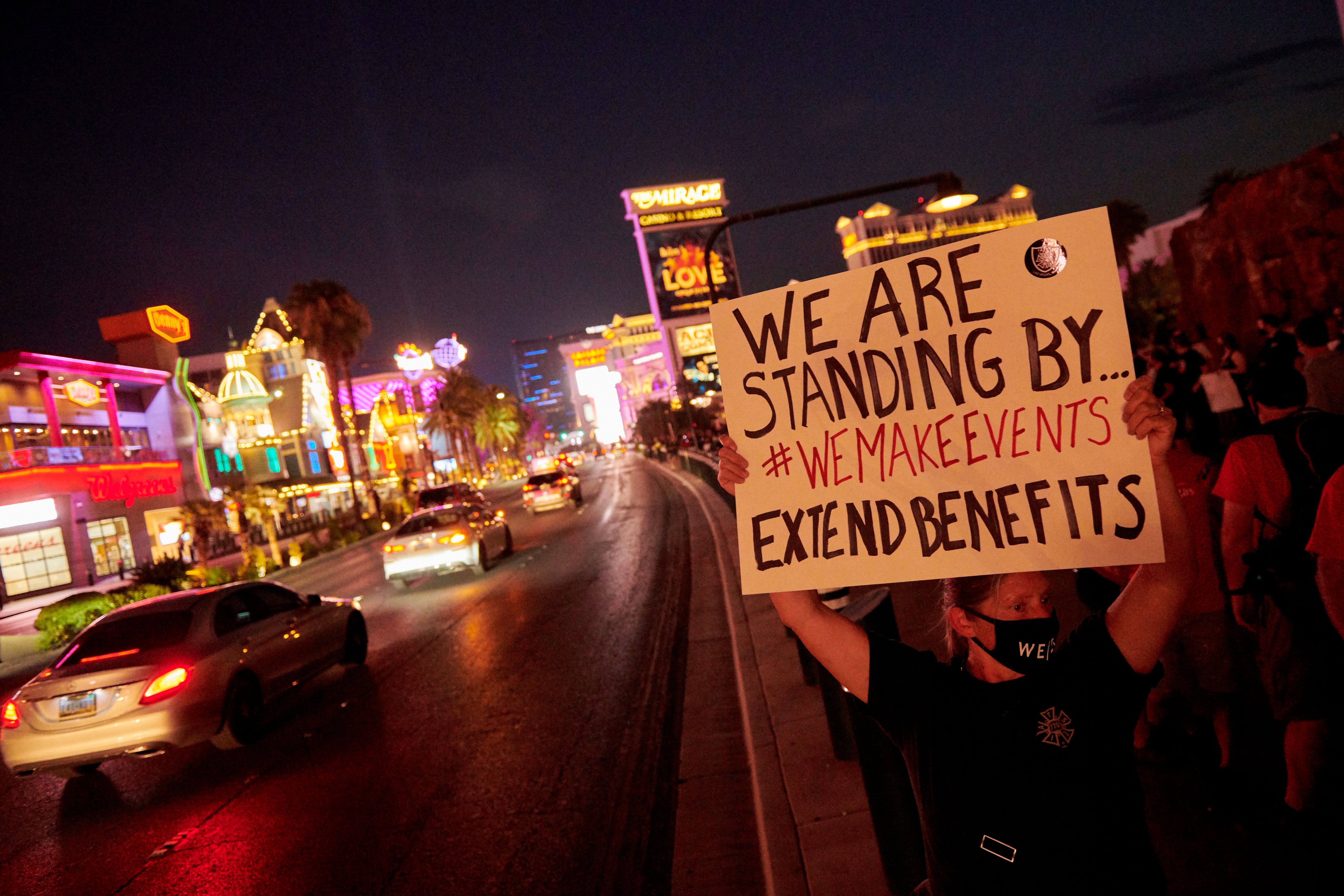Events and entertainment workers protest unemployment on Aug. 19 in Las Vegas.
BRIDGET BENNETT/AFP via Getty Images)
It’s a hard time to try to plan your finances. Unemployment benefits and another round of stimulus checks are up in the air. Evictions are banned, but only temporarily.
Much of the uncertainty is due to the fact that Congress has been unable to strike a compromise on another stimulus package. Most of the relief measures delivered to Americans in the $2.2 trillion CARES Act, including weekly $600 federal unemployment checks, have come to an end.
Most recently, Democrats blocked Republicans’ proposal for a reduced coronavirus aid package, saying that it was an inadequate response to Americans struggling amid one of the steepest downturns in history. “Republicans may call their proposal ‘skinny,’ but it would be more appropriate to call it ’emaciated,'” Sen. Chuck Schumer, D-N.Y., wrote to Senate Democrats.
With negotiations over the shape of the next government stimulus package in a stalemate, President Donald Trump took executive action in August to pass a patchwork of federal aid.
For now, it’s only these measures that Americans can count on.
Unemployment benefits
Trump said he would send jobless Americans a $400 weekly payment. Yet, because the policy would require states to come up with $100 of that expanded benefit, most people will actually end up with $300 a week, though Montana, Kentucky and West Virginia have found a way to give out the whole amount.
What’s more, states might not have more than six weeks’ worth of these payments. In some cases, it may be even less. South Dakota has said it won’t apply for the funds at all, for example, and Nevada is yet to be approved for the program.
Beyond the federal boost, most jobless Americans will continue to get state unemployment benefits. Thanks to the CARES Act, most workers will be able to collect these payments for 39 weeks, or even more in some cases.
More from Personal Finance:
At least 20 states start paying extra $300 weekly unemployment benefit
The CDC banned evictions, but some renters are still vulnerable
Still haven’t filed your 2019 tax return? Penalties are about to get steeper
Stimulus checks
Until this week, another round of cash payments to Americans had bipartisan support and seemed all but certain. Yet in Republicans’ most recent relief proposal, there was no mention of stimulus checks.
Trump’s executive action taken in August also didn’t include the payments; it’s up to Congress to authorize another round.
Evictions are banned for now
As millions of Americans grapple with a loss in income and difficultly meeting rent, most should at least be protected from eviction until the end of the year.
That’s because earlier this month, the Centers for Disease Control and Prevention made it illegal for landlords across the U.S. to evict most tenants who can’t afford to pay their rent.
Renters will need to sign a declaration form and give it to their landlords to make sure they’re protected. To qualify, individuals have to expect to earn less than $99,000 a year in 2020 and couples, under $198,000.
The ban could prevent up to 40 million Americans from losing their homes amid the coronavirus pandemic.
Tax cuts
Trump called for a temporary cut to payroll taxes during the pandemic. The suspension of the 6.2% tax employees pay toward Social Security will last until the end of the year, and applies to workers who earn no more than $4,000 per bi-weekly pay period.
But many employers will likely not give their workers’ larger paychecks and just continue to withhold the levies for when and if they’re eventually due to the government.
A break from student loans
Trump’s executive order also granted people with federal student loans a break from their bills until January, during which interest will not accrue. There have been some questions over whether such a move is constitutional, but the U.S. Department of Education has now announced that it will fully implement the president’s memorandum.
The payment pause through Dec. 31, 2020, is automatic. If your loans qualify for the reprieve, you shouldn’t have to request it with your servicer, unlike the Education Department’s usual forbearances and deferments.
Put another way, “borrowers don’t need to do a darn thing,” said Mayotte.
